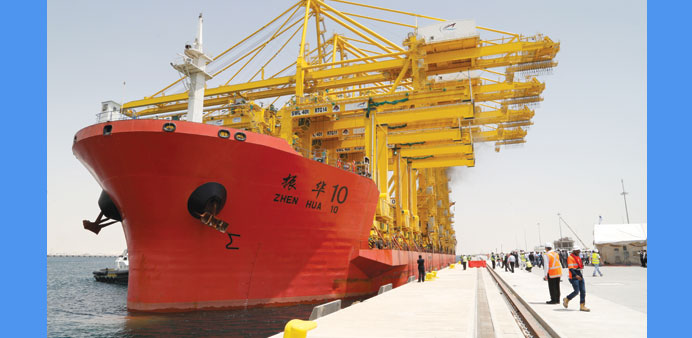Hamad Port’s first vessel, heavy load carrier Zhen Hua 10 from China, which arrived at the new port at Umm Alhoul in Mesaieed recently. Hamad Port at Mesaieed is expected to further add impetus to the transport and logistics sector in Qatar. PICTURE: Jayaram
By Santhosh V Perumal/Business Reporter
Qatar’s transport sector witnessed a healthy double-digit expansion in profitability in the first half of this year, mainly on the back of earnings in logistics segment; reflecting the promising potential for the sector in view of vast opportunities in the infrastructure development in the country.
The cumulative net profit of the transport sector, which has three listed constituents, grew by 19.21% in January-June this year against 4.65% in the corresponding period of 2014, according to the Qatar Stock Exchange data.
The transport sector had seen its index expand 5.69% in the first half ended June, outperforming the main barometer that saw 0.69% fall; indicating the prospects that lie within the sector.
The overall sectoral profitability was boosted by Milaha (Qatar Navigation), which had reported 26% growth in earnings compared to 10% fall in the year-ago period; even as Nakilat’s profit saw considerable slowdown (10% against 24%) and Gulf Warehousing’s earnings were rather flat.
Qatar’s fast growing non-hydrocarbon sector as part of diversification, the mammoth $200bn capital expenditure for infrastructure upgrade in the run up to 2022 FIFA World Cup, the establishment of economic zones and the fast coming up Hamad Port all augur well for the transport and logistics sector in the long term, according to market experts.
The major development projects have brought with it the need to enhance capacity building in the country’s logistics sector in line with the growing population, a source in a logistics company said, adding with government streamlining the customs procedure and moving into an internationally accepted structure, the sector has been witnessing cost advantages in terms of fewer documents and lesser time to import and export.
“A holistic approach is needed in the transport and logistics sector, especially considering the priorities of the projects and its backward and forward linkage to the overall macro economy,” an analyst tracking the sector said. Fast execution of economic zones has redefined the scope of transport and logistics sector, which otherwise was heavily dependent on the hydrocarbons, whose share in the country’s gross domestic product has been shrinking (in view of weak energy prices), he said.
Hamad Port at Mesaieed, which has already received the first ship and whose first phase is set to be operational by the year end, will further add impetus to the transport and logistics sector, he added.
Import led economies like Qatar have always offered tremendous scope for third party logistics and international freight forwarding, a market source said.
However, another school of thought is that given that many of the projects have been relegated owing to changed priorities of the government, the potential for the transport and logistics sector is not that as big as it was expected a couple of years back, when the country had more than ample leeway during oil price boom.
“One has to discount the apprehensions regarding uncertainties at a time when many projects are put on hold but those projects have low priorities and to that extend their influence on the economy will also be lower,” the source in the logistics sector, however, countered.

